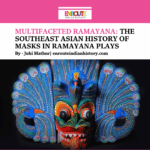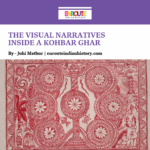Sanjhi Ki Sundarta: How a Stencil Art Celebrates the Romance of Radha-Krishna
- EIH User
- January 23, 2023
Article Written By EIH Researcher And Writer
Devanshi Panda
Stencil art. These two words might immediately trigger images of round-shaped stencils that people across India now use to create rangolis whenever Diwali comes around. These sieve-type stencils require minimal effort. All one needs is powdered colour, which is spread across the sieve and sifted to create beautiful images of diyas and shubh labh on floors. While these stencils are now manufactured on a large scale by machines, the ancient art of Sanjhi, or stencil art, is a much more complicated hand-made craft.
While it is not sure when stencilling came to India, it is probably due to the Chinese that Indians were introduced to the art. In the fifteenth and sixteenth centuries, Sanjhi got linked to Vrajbhoomi, or the towns of Mathura and Vrindavan, both important towns regarding the legend of Lord Krishna.
There are various folk etymologies associated with the term “Sanjhi” itself. One opinion links it to the Hindi word “sajjavata”, which is connected to the Sanskrit “sajja” meaning decoration. A more popular opinion connects the word to “sandhya,” or evening in Sanskrit, which is “sanjha” in Brajbhasha. This view is accepted since the worship of the goddess, also called Sanjhi, took place during the time of dusk. A third viewpoint links the term to “samaja,” meaning community or group, thus extolling the idea that the art was an activity that was done communally. The word Sanjhi could also be a corrupted form of the word “sancha”, which means “a mould that creates identical impressions.”
Sanjhi underwent three important phases in its development in Vrindavan. The first was the folk stage. Herein, young girls would adorn the walls of their homes with coloured stones, metal foils, and bits of mirrors on a background of cow dung during the pitra paksh, or dark fortnight of the waning moon in the month of Ashwin (the seventh month of the lunisolar Hindu calendar). Each day a new Sanjhi design would be made, and it would reflect stories from the lives of the goddess Sanjhi and her husband Sanjha. This practice was believed to bring good husbands and many children to those unmarried girls who worshipped the images with utter devotion. Popular folklore that is often mentioned by Sanjhi artists pertains to the tradition of Sanjhi beginning with Radha. Radha is said to have adorned her walls with Sanjhi art to attract Krishna, and seeing her, other gopis soon followed sSumit Goswami, a Sanjhi artist, expresses in a Doordarshan informational video on Sanjhi art how Krishna is said to have performed many leelas for Radha, but if there is one leela that Radha has performed from Krishna, it is undoubtedly the art of Sanjhi.
The second stage was the poetic tradition. The ritual practised by the unmarried girls triggered the depiction of Sanjhi in Brajbhasha poetry, which emphasised the role of picking forest flowers to make the design of the Sanjhi. Visuals in the poetry included the interactions between Radha, Krishna, and the sakhis and the preparation for the evening Sanjhi by the gopis and Radha by going to the nearest forest to gather fresh flowers.
Around the seventeenth century, Sanjhi slipped through the cracks of home walls and onto the floors of the Vaishnav temples. Flower Sanjhis are still an integral part of the temple tradition at the Radhavallabh temple, and this is considered the third phase. The flower Sanjhis are the only ones made by girls in the temple. Sanjhi is said to have been made into a refined, fine art by the Brahmin priests. Previously, sanjhis were made with natural, plant-derived colors.ntempoCurrently colours are formulated by mixing pigments with marble powder. After the preparation of colours, lines are demarcated using a thread dipped in blue powder onto the vedi, or a raised earthen platform. This is called preparing the furma. Thereafter, the borders are filled with vibrant colours, and this is called creating the pacheli. The stencils, originally made from banana leaves but now increasingly made from handmade or recycled paper, are then used to create designs of bel leaves and other creepers and flowers on the borders. The texture of the paper matters, as it has to be stiff and strong while preferably still retaining a translucent quality. The stencils are made using a unique type of scissors that are slightly curved at the end to allow for precision. They are customised to each artist’s specific requirements and are wrapped in a cloth after their use, as a sign of respect for the instrument and also to protect the tip. These stencils in themselves are masterpieces, and many artists who create them do not requre rough sketches; they can swiftly cut out intricate shapes without any outline. Using small cloth sacks filled with colours, the stencils are filled in using the fingers to distribute the colour evenly onto the platform. To make the process of lifting the stencils easier and not cause a mess, the artists employ a clever technique in all types of Sanjhis: they fold the corners of the stencils upwards to create mini handles. The stencil can then be lifted by the corners of the stencil, which has to be done in a single motion. After the border work is done, attention is given to the center of the design, the highlight of the Sanjhi. Radha-Krishna’s leelas are depicted in the center. The entire Sanjhi features motifs like peacocks, cows, bullock carts, creepers, flowers, etc. In many of the colourful designs, a gradient technique is employed; different colours are filled onto different portions to give it a striking effect once the stencil is removed. The last stage of creating the temple Sanjhi is called bharav jagana. This is the process of finessing the piece; colouring in areas that might have been left out, darkening colours where the colour is not prominent enough, correcting areas where colours might have been accidentally distorted, etc. With the last stage of final touches, the Sanjhi becomes ready for darshan, viewership by the devotees. The deification and worship of Sanjhi are what make it different from rangolis.
Apart from the flower Sanjhi and the temple Sanjhi, Sanjhi is also made beneath and above water, called Jal ki Sanjhi. A shallow dish is first coated with oil before the Sanjhi is submerged in water. Then, insoluble colours are employed to make a design on the oil using a handmade stencil. Excess colour is removed by tipping the dish to one side. Water is then poured in gently from the side so as not to disturb the design. The floating Sanjhi is perhaps the most striking and difficult to create. Either water is added to the oil-lined vessel so that oil rises to the top, being lighter, and provides a base for the Sanjhi, or water is poured directly into a dish and a base powder is first spread across the water to form a firm background for the design. On the water, the stencil has to be placed with the utmost precision before it is filled with colours. The Jal ki Sanjhi is also floated along the banks of the Yamuna after the evening prayer with diyas, creating a fantastic display. It is popular in Udaipur. The delegates of the G20 summit were treated to an exhibition of the same in the city in December 2022.
Mohan Verma, a Sanjhi artist, believes that making the stencils requires feeling and emotion. Imagining Krishna in various instances, for example, sitting atop a tree branch or frolicking with the gopis, is what inspires the cut-outs of the stencil, which is also called khaka. Mohan Verma is sensitive in his treatment of the paper with his scissors; he does not wish the sharp edges of his scissors to hurt Krishna when he is creating the silhouette of the Lord’s figure. This art form is propelled by devotion to the Lord.
Unfortunately, devotion is not enough to sustain this art form, which is gradually going extinct. One only gets to see it primarily in temples. It is practised by only a select few, and interest in it is dwindling at a steady rate. Nevertheless, the wonders of Sanjhi must be known to the world, and the skilled craftsmanship behind it must be appreciated. An interesting development of Sanjhi is that the stencils have gone from facilitating the process of creating designs to becoming final products in themselves. The stencils are now sold as cards, as part of lampshade decorations, as wall hangings, as board game covers, and more. Artists like Ram Soni have also begun to modernize their techniques and have changed the medium of some stencils from paper to plastic.
While the Jal ki Sanjhi may dissipate after a few hours, the artists’ devotion and dedication to keeping this art alive will endure.
References:
1.Dasa, A. (1996) Evening blossoms: The temple tradition of Sanjhi in vṛndāvana Indira Gandhi National Centre for the Arts.
2.Sanjhi: Folk art of Mathura and Vrindavan (2020). Kolkata: Eastern Zonal Cultural Centre.
3.Sanjhi Kala (2019) YouTube. IGNOU & School and Teacher Education (NCERT). Available at: https://youtu.be/XJKuYDvbEnM (Accessed: January 20, 2023).
4.Kumari, R. et al. (2022) G20 India: Delegates witness the magic of Jal Sanjhi, newsonair.com. Available at:https://newsonair.com/2022/12/05/g20-india-delegates-witness-the-magic-of-jal-Sanjhi/ (Accessed: January 20, 2023).
5.Jaity, J. Handmade paper and the art of Sanjhi – Google Arts & Culture, Google. Google. Available at: https://artsandculture.google.com/story/handmade-paper-and-the-art-of-Sanjhi-dastkari-haat-samiti/AQXhM-u5KHJpJw?hl=en (Accessed: January 20, 2023).
6.Mathura Ke Sanjhi Kala (2021) YouTube. Doordarshan Mathura. Available at: https://youtu.be/s7cnN7AZykw (Accessed: January 20, 2023).
7.Sanjhi Craft (2021) Sanjhi Craft. Available at: https://industries.rajasthan.gov.in/content/industries/handmadeinrajasthandepartment/artandcraft/papercraft0/Sanjhicraft.html (Accessed: January 20, 2023).



















